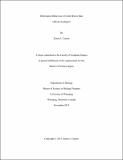| dc.contributor.author | Czenze, Zenon | |
| dc.date.accessioned | 2014-09-25T17:51:27Z | |
| dc.date.available | 2014-09-25T17:51:27Z | |
| dc.date.issued | 2014-09-25 | |
| dc.identifier.citation | Czenze, Zenon. Hibernation Behaviour of Little Brown Bats (Myotis lucifugus); A thesis submitted to the Faculty of Graduate Studies in partial fulfillment of the requirements for the Master of Science degree, Department of Biology, University of Winnipeg. Winnipeg, Manitoba, Canada: University of Winnipeg, 2013. | |
| dc.identifier.uri | http://hdl.handle.net/10680/743 | |
| dc.description.abstract | For temperate endotherms (i.e., mammals and birds) energy costs are highest during winter but food availability is lowest and many mammals depend on hibernation as a result. Hibernation is made up of energy-saving torpor bouts [periods of controlled reduction in body temperature (Tb)], which are interrupted by periodic arousals to normothermic Tb. What triggers these arousals in free-ranging hibernators is not well understood. Some bats with access to flying insects during winter synchronize arousals with sunset, suggesting that feeding opportunities may influence arousal timing. I tested whether hibernating bats from a cold climate without access to food during winter also maintain a circadian rhythm for arousals. I used temperature telemetry to monitor skin temperature (Tsk) of free-ranging little brown bats (Myotis lucifugus) hibernating in central Manitoba, Canada. I found no evidence bats, during late winter, synchronized arousals with photoperiod. However, during early spring, as emergence date approached I found bats resumed a circadian pattern of arousals and aroused synchronously with sunset. Female bats give birth after emergence and must emerge earlier from hibernation in good body condition with fat reserves remaining. Difference in reproductive investment should lead to differences in torpor/arousal patterns and emergence timing. I found that males exhibited longer periodic arousals than females, that females emerged earlier than males, independent of environmental conditions, and that male emergence date was predicted by warming cave temperature. Longer arousals by males could reflect mating attempts by males and/or the strong selection pressure on females to be “thrifty” with their fat reserves and emerge in good condition to support pregnancy. These findings provide valuable new insights in hibernation behaviour, phenology, and energetics. | en_US |
| dc.language.iso | en | en_US |
| dc.publisher | University of Winnipeg | |
| dc.rights | info:eu-repo/semantics/openAccess | |
| dc.subject | Bats -- Canada. | en_US |
| dc.subject | Bats -- Reproduction. | en_US |
| dc.subject | Bats. | en_US |
| dc.subject | Bats -- Ecology. | en_US |
| dc.title | Hibernation Behaviour of Little Brown Bats (Myotis lucifugus) | en_US |
| dc.type | Thesis | en_US |
| dc.description.degree | Master of Science in Biology | |
| dc.publisher.grantor | University of Winnipeg | |
| thesis.degree.discipline | Biology | |
| thesis.degree.level | masters | |
| thesis.degree.name | Master of Science in Biology | |
| thesis.degree.grantor | University of Winnipeg | |

